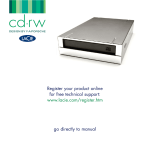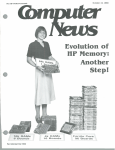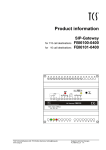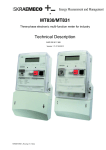Download Hey, guy! Watch out for guy wires!
Transcript
August 2011 Vol. 15, No. 8 Hey, guy! Watch out for guy wires! Looking at the poles of your electric cooperative’s distribution system, you may be tempted to think the guy wire doesn’t look that important. All it does is go from the pole to an anchor in the ground and serves as extra support. It can’t be nearly as important as the wires between the poles that carry electricity to your home, right? Not quite. Guy wires should be treated with as much respect as powerlines. In December of 2010 a broken guy wire caused a power outage for 8,500 members of the River Valley Electric Cooperative, Branson, Missouri. The guy wire broke, reducing tension on the power lines, which knocked out a breaker, which fed three substations. One of the most important functions of the guy wire is to keep tension on lines and to prevent sag. If the lines sag, they can slap into each other in winds. If you see a broken, limp or sagging guy wire or hit one with your tractor or vehicle, be sure to let your electric cooperative know. Even the plastic sleeve serves an important function. It makes the guy wire more visible to snowmobilers during the winter months. Do guy wires serve any function in protecting the lines from lightning? No, but since the guy wire is attached to an anchor driven into the Earth, it is an easy path to the ground for lightning. Guy wires might not carry power, but they keep power lines and poles where they belong for a reliable distribution system. If one gets damaged, call your co-op; it needs to be repaired. Affordable. Innovative. Member Focused. It’s hard to predict the future, but one thing seems certain — new government regulations will increase the cost of electricity. We want to work with you to keep your electric bills Affordable. We’re controlling costs through Innovation and no matter what the future holds, we’ll continue to put you, our members, First. We’re looking out for you, our member-owners. Brown County Rural Electrical Association Connecting our co-ops & members to a progressive future Inside this issue: Load management makes a difference...Page 4 Load management options...Page 5 Connect ons Cooperative Alliance Partners This publication focuses on CAP’s members, programs and events. As this is the official member publication, member’s story ideas, letters-to-the-editor and comments are welcomed. Andrea Christoffer, CCC, Editor “Owned by those it serves” Connections (USPS 010-456) is published monthly by Federated Rural Electric, 77100 US Hwy 71, Jackson, MN 56143. Subscriptions: Members $5 a year. Nonmembers $10 a year. Periodicals postage paid at Jackson, MN and additional mailing offices. POSTMASTER: Send address changes to Connections, PO Box 69, Jackson MN 56143-0069. Printed by Livewire Printing, Jackson, on recycled paper with soy ink The next generation of hot water heater? Heat pump water heaters undergo local testing The majority of co-op members are familiar with the co-op’s water heater program. However, a new option is being tested by 15 Minnesota electric co-ops. “Last fall Great River Energy (GRE) initiated a test of three brands of heat pump water heaters,” stated Vicki Belanger, GRE test program coordinator. “We sought co-op employees with four members in the household so we would have a standard comparison. Three different brands were selected for the test. Each household had to have a meter installed on the existing co-op water heater to see how much electricity it used and then meter the electricity used on the heat pump water heater as well.” Water heating can account for up to 25 percent of the energy consumed in a home, according to the U.S. Department of Energy. Heat pump water heaters look similar to standard tank water heaters; the main difference is where the heat comes from and how much energy is used. Inside a heat pump water heater, a refrigerant passes through an evaporator where it absorbs heat from the air. The heated refrigerant then moves a compressor that raises its temperature before it is used to heat the water in the tank. In other words, the heat pump water heater uses electricity to move heat from one place to another, rather than 2 Cap off your savings with a heat pump water heater! Heat pump waters heaters are currently being tested by co-op members. Are they the future? Read to find out. generate heat. As a result, the unit uses roughly half the electricity of a conventional electric water heater. “We are about halfway through the test year and are impressed with the results so far,” Belanger stated. “We are seeing significant energy savings and it is more than we anticapated.” Locally, Federated employee and member Andrea Christoffer and herRound Lake family are testing the heat pump water heater. “I am quite impressed with the water heater sav- ings. We had a 100-gallon Vaughn water heater from the co-op. “Our heat pump water heater is located in the back corner of our basement, which is open to the family room,” Christoffer stated. “In that corner of the basement the temperature is definitely about 10 degrees cooler than the rest of the basement. In the summertime, it’s the coolest area in the whole house, plus it dehumidifies too! The heat pump water heater sounds like a dehumidifier running due to the compressor. After our morning showers the heat pump will run most of the morning to re-heat that water using the indoor air in heat pump mode. “During the coldest days of winter we pushed one button to switch it off the heat pump mode and to electric element mode,” added Dean Christoffer. “It also has a hybrid mode where both the heat pump and elements are used. “I was a little concerned about the maintenance of the unit with more moving parts,” Dean stated. “Periodically, you have to blow off the unit’s air filter. Plus, a tube had to be run to the basement drain for the moisture dehumidification.” These heat pump water heaters cost about $1,500 to $2,000, plus installation, which takes a bit longer than a standard install. However, federal tax credits pay up to $300 in 2011 only. The trial period will conclude this fall. These results will help your electric cooperative decide on the future path for its water heater program. Connections — August 2011 Introducing the HAL 9000 of floor-cleaning robots — Mint While the dream to put a robot butler in every home that cooks, mows the lawn and does laundry stalled, homeowners can at least own a robot that will perform their floor cleaning. The Mint Automatic Floor Cleaner from Evolution Robotics sweeps and mops hard floors. Using dry and pre-moistened cleaning cloths, Mint picks up dust, dirt and pet hair. Its compact design gets into tight spaces, under furniture and into other areas that are hard to reach with traditional mops and sweepers. Guided by the NorthStar Navigation System cube, Mint tracks where it cleans so it does not miss a spot. The system works like an indoor GPS and helps Mint keep track of where it has been and where it needs to go. After Mint finishes cleaning open areas and around obstacles, it per- The Mint, along with its navigation system (square unit), will clean your hard-surface floors! forms a final edge cleaning along walls and furniture and then returns to where it started. Smart sensors help Mint avoid area rugs and raised carpet transitions, detect areas that are too low to enter and even avoid falling down stairs. What do you have to do? Simply attach your cleaning cloth of choice. In sweep mode Mint uses a dry sweeping cloth to pick up dust bunnies, pet hair and grit from your floor. In mop mode Mint cleans with a pre-moistened cleaning cloth and a special back-and-forth mopping motion to pick up deeper dirt and grime. Mint works with commonly available disposable cleaning cloths or with re-usable microfiber cloths. These microfiber cloths can be re-washed and re-used hundreds of times. Mint can map and clean up to 1,000 square feet either in a large open space or by discovering adjacent rooms. In mop mode the cleaning area is restricted to 250 square feet to optimize cleaning, while the cleaning cloth is wet. Mint’s dual modes let you maintain all your hard surface floors with one device. Since Mint is not a vacuum, no bins require emptying or filters need replacement. Mint includes two C batteries, two dry sweeping microfiber cloths, one wet mopping microfiber cloth, power adapter, quick start guide and user manual. The floor cleaning robot is backed by a one-year warranty. Mint sells for approximately $200 and is available from online retailers like Amazon.com. Empower yourself when it comes to power tool safety Power up on power tool safety tips. • Never carry a tool by the cord. • Never yank the cord to disconnect it from the receptacle. • Keep cords away from heat, oil, and sharp edges (including the cutting surface of a power saw or drill). • Disconnect tools when not in use, before servicing and when changing accessories such as blades, bits, etc. • Avoid accidental starting. Do not hold fingers on the switch button while carrying a plugged-in tool. • Use gloves and appropriate safety footwear when using electric tools. • Store electric tools in a dry place when not in use. • Do not use electric tools in damp or wet locations unless they are approved for that purpose. Connections — August 2011 • Ensure that cords from electric tools do not present a tripping hazard. • Remove all damaged portable electric tools from use and tag them: “Do Not Use.” • Use double-insulated tools. Double-insulated tools help protect against electrical shock. An electrical shock in a tool can occur, for example, from worn wiring that lets bare wire touch the frame of an appliance. Double-insulated tools have an outer casing of plastic or some other nonconductive material and are the only tools with two-wire plugs sold today that are approved by the Underwriters Laboratories (UL). • Keep work areas well-lit when operating electric tools. • If you use extension cords, make sure the cords are well maintained and in good working order. — Courtesy of safeelectricity.org 3 Brown County Briefs Grab the phone before you grab the shovel One call gets your utility lines marked and protects you from injury and expense. Always call before you dig 1-800-252-1166 or 811. It’s smart, it’s safe and it’s the law! Round up meeting The Brown County REA Round Up Trust Board will meet Tuesday, August 16, at 7 p.m. Member Advisory Council The next meeting of the Brown County REA Member Advisory Council will be Monday, September 19, at 7:30 p.m. Radio receiver upgrade Work is in progress to upgrade Brown County REA’s load management radio receivers — the gray box that controls your water heater, air conditioner, heat pump, generator, etc. during peak usage — to a version which will be compatible with a new frequency. The process will take place by township until the entire service area is upgraded between now and January 1, 2013. An automated message will be delivered to your phone to alert you when work is taking place in your area. The contractor will need access to your electric panel to change and re-connect the receiver. If you have a radio receiver that is no longer in use, or if you have removed a receiver while re-siding or other work on your home and it has not been reconnected, please contact us. Thank you! 4 Load control takes a load off the distribution system and your bills! The recent waves of extreme heat and humidity have generated numerous phone calls and questions to Brown County REA regarding our load management programs. Here’s a refresher on the workings of the programs. The basics Load management or demand response is a strategy that Great River Energy (GRE), our wholesale power supplier, uses to reduce the demand for electricity during occasional “high demand” periods such as hot summer days. Demand response helps GRE to avoid the building of high-cost peaking plants or the purchase of high-cost energy in the wholesale market. Brown County REA has more than 3,300 load Receivers like this one attach to the management receivers at members’ side of your home and control your locations throughout the system. More water heater, electric heat or air conthan 200,000 co-op members from ditioner during times of high power the 28 cooperatives, which make up demand. GRE, participate in demand response programs through their local cooperative. The cost of electricity is constantly changing. The kilowatt-hour delivered at dinner time is far more expensive than the one delivered at midnight. Our load management programs exist to take advantage of that cost difference to keep costs lower for all our members. GRE purchases all of its energy from the Midwest Independent Service Operator (MISO) energy market. MISO is responsible for matching the amount of electricity generated to the amount being consumed 24 hours a day, seven days a week, 365 days a year. As consumers use more electricity, MISO must increase the number of generators needed to supply that energy. As more generators are brought online, the price of electricity increases. Load management programs allow us to influence the amount of load consumed during peak times. Brown County REA will be closed for Labor Day, September 5 Crews will be on-call in case of outages Connections — August 2011 A load of load management programs! If you don’t participate in any load management program, you have a variety to choose from. Check out the different options and see if one might work for you. Cycled air conditioning Cycled air conditioning is available to members who have central air conditioning units and/or hardwired room air conditioners, which are connected to a load control radio receiver provided by the cooperative. The receiver cycles the cooling system on and off to minimize extreme peaks in electricity demand that are caused when every air conditioner operates at the same time. When air conditioning is being controlled, a unit will be cycled off for approximately 15 of every 30 minutes. Only the compressor is turned off during the cycle period; the fan continues to run. Under the program rules, cooling systems can be controlled up to six hours per day for no more than 200 hours per cooling season. Typically when air conditioners are being controlled, homeowners hardly notice their service is being interrupted. However, during the recent events of extreme heat, dew points and humidity, some members reported that their air conditioners were having trouble maintaining a comfortable temperature during the cycling periods. Even some air conditioners not on load management programs struggled to keep up during the extremes. If you have a central air conditioner or heat pump that is more than three years old and has not had a tune-up in the last two years, you may want to have it checked over to see that all parts of the system are operating properly. Submit proof of the tune-up to BCREA and receive a $25 credit on your electric bill. Interruptible water heating Interruptible water heaters are interrupted for up to eight hours on days of high electrical demand, high wholesale energy prices and/or system emergencies. An interruptible water heating system has sufficient storage capacity to supply the user’s hot water needs over the peak period when the electric supply is interrupted. Once the signal is sent to the load control receiver, power can be shut off to the water heater for up to eight hours during a control event all months of the year when needed. If a member uses the tank’s capacity of hot water while under load control, it will not begin heating again until Connections — August 2011 after the control time has ended. The minimum storage capacity to qualify for load management is 50 gallons. To avoid seasonal high wholesale prices interruptible water heating is primarily controlled during June, July, August and portions of December, January and February. ETS water heating Electric Thermal Storage (ETS) water heating system uses inexpensive off-peak electricity to “charge” a water heater with sufficient storage capacity to supply the member’s hot water needs over an extended period each day when the electric supply is interrupted during the on-peak hours the following day. ETS water heaters are recharged for eight hours each day, generally between 11 p.m. and 7 a.m. Typically a 105-gallon storage capacity is used for ETS water heating. CI&A programs The Interruptible Commercial, Industrial and Agricultural (CI&A) program allows Brown County REA/GRE to reduce capacity and energy requirements during peak load conditions by interrupting all or a portion of a CI&A member’s electric load. Brown County REA has Interruptible C&I customers who agree to reduce their electrical energy load to an agreed upon Predetermined Demand Level (PDL) measured in kilowatts (kW) for up to six hours per occurrence. Other CI&A customers participate in the full interruptible with generator backup program (C&I with GenSet) and agree to transfer their entire electricity load to a customerowned generator for up to 10 hours per occurrence. Interruptible irrigation Interruptible irrigation is designed to provide member cooperatives a way to eliminate the demand created by irrigation systems from their billing peaks. Irrigation systems may be interrupted once per day for four hours during the cooling season, May through September. GRE uses its best efforts to schedule irrigation control times on a consistent basis each day, usually from 4 to 8 p.m. Brown County REA greatly appreciates all the members who participate in load management to contribute to keeping rates lower for all. If you have questions on whether or not control is taking place on any given day, go to www. greatriverenergy.com and click on the Load Management tab on the lower right side of the page. 5 Mother Nature sets off stormy fireworks July 1 causing outages at nearby co-ops Some electric co-op members were not starting up fireworks early last month, but chain saws instead. A July 1 storm caused damage at several electric co-ops’ service areas, knocking down buildings, trees and power lines. Your local electric co-op had minor outages. Line crews spent most of their time helping neighboring electric co-ops restore power. “Helping others is one of the cooperative principles,” stated Federated’s Joe Marthaler, operations manager. “You never know when it could be your co-op. We lend a hand so when Mother Nature strikes we can get the co-op members back on as quickly as possible.” “I commend our line crews for working over the holiday weekend and sacrificing their own plans,” said Mike Heidemann, Brown County REA line superintendent.” “Line crews rise up to the challenge of seeing how many members can be restored as quickly as possible,” added Mark Anderson, South Central operations manager. Federated linemen Mort VanDeVere, George Madden and Joe Marthaler assisted at Lyon-Lincoln Electric Co-op based in Tyler putting in 47 hours each over three days. This co-op had all members without power due to an EF-2 tornado and the loss of transmission line poles. Crews helped restore power to about 1,500 co-op members. The cooperative’s headquarters building even experienced significant storm damage. 6 Renville-Sibley Co-op Power Association in Danube had 1,538 members without power with the longest outage just shy of five days. Brown County Rural Electrical Association crews helped July 1-4 working 288 hours as a group. BCREA line crews involved: Dylan Maas, Larry Soukup, Tom Hillesheim, Adam Fischer, Brandon Havemeier, Mike Suess and Pat Harkin. Not pictured: Joe Soukup and Steve Walter. South Central Electric’s line crews assisted Redwood Electric Cooperative July 1-4. Redwood had about 900 members out of power July 1. All but a handful were restored by 7 p.m. July 4. Linemen that lent a helping hand: Nick Willardson, John Husby, Matt Winkelman, Greg Giese, Mark Meier, Troy Determan, Adam Johnson and Keith Scheidt. Not pictured Luke Malmgren and Tanner Smith. Connections — August 2011 ‘Eggs’tra, ‘Eggs’tra, read all about it ! Share egg recipes Share with us your “eggs”iting recipes, whether it’s egg bake, egg salad, omelets, deviled eggs or even quiche. Mail to: Editor, Federated Rural Electric, PO Box 69, Jackson MN 56143-0069 or e-mail to [email protected]. Otherwise, drop it off at your local electric co-op. Add your name and phone number. Thanks for sharing! Chuckwagon Beans by Linda Olson, St. James 1 lb. bacon 1/8 tsp. pepper 3 lb. ground beef ¼ tsp. salt 1 med. onion, chopped 1 T. dry mustard ¼ tsp. garlic powder 1½ c. catsup 3 cans (1 lb. 12 oz. size) Bush’s Baked Beans Heat oven to 375º. Fry bacon until crisp. Drain. Cook ground beef and onion until done. Mix the ground beef with all of the ingredients except the bacon. Crumble three-fourths of bacon and add to mixture. Bake 90 minutes. Crumble and sprinkle remaining bacon on top of the beans. Call before digging 1-800-252-1166 Call 48 hours in advance before digging more than 12" deep. Calico Bean Bake by Julie Halvorson, Madelia 1 lb. bacon, cooked crisp & cut into pieces 1 lb. hamburger, browned with onion & drained 1 large onion, chopped 16 oz. can kidney beans, not drained 16 oz. can small butter beans, not drained 16 oz. can pork and beans 2 T. white sugar 1/3 c. brown sugar, packed ¼ c. ketchup ¼ c. BBQ sauce (I use Cookies) 2 T. prepared mustard 2 T. molasses ½ tsp chili powder 1 tsp. salt ½ tsp. pepper Put all of the ingredients in a crockpot and heat. Change air filter to save money & energy It’s hot this summer. That means your air conditioning system is working hard to keep you comfortable. This energy saving tip can help your cooling system operate more efficiently — and save you money. Change your air filter regularly. It only takes a couple of minutes to change the air filter in your heating/cooling system. It’s simple and easy. As TogetherWeSave.com has shown, changing your filter every month can save you $82 a year. A dirty air filter makes your system work harder to keep you cool, which wastes energy. Changing your air filter regularly helps to ensure efficient operation and keep your electricity bill in check. What’s more, a dirty air filter allows dust and dirt to build up in your system. Changing your air filter regularly can reduce the need for costly maintenance and prevent damage to your system. When winter arrives, it’s just as important to change your air filter regularly. Your heating system needs to work as efficiently as possible to keep you warm and a clean air filter helps it do that. Experts recommend turning your system off before changing the air filter. Make sure that the arrow on the filter, which indicates the direction of the airflow, is pointing with the air flow. When you’ve made the change, turn your system back on. To save time it’s a good idea to keep a couple of spare filters on hand. For other tips on how to save energy visit Touchstone Energy® Cooperatives energy-saving website www.TogetherWeSave.com or call the efficiency experts at your local electric cooperative. Connections — August 2011 7 Brown County Rural Electrical Association Staff notes “Report card” allows us to compare co-op statstics Each year we receive from our lenders a statistical analysis comparing Brown County REA to many different groups of electric cooperatives. Those groups include co-ops our size, co-ops growing at the same rate as BCREA, co-ops with the same power supply, Wade Hensel General Manager co-ops in Minnesota and all the co-ops in the United States. These comparisons are reviewed with the Board of Directors to provide information to the board on how the cooperative is doing in terms of cost, service, rates and financial stability. This month we are reviewing with the board a Key Ratio Trend Analysis done by Cooperative Finance Corporation. They have assembled 145 ratios for review. The report shows that BCREA has an aggressive program of retiring or paying back capital credits to our members, while still maintaining quite low rates. BCREA retires nearly twice as much in capital credits each year compared to the equity than do most cooperatives nationally. Your cooperative’s rates are among the lowest in the state, nation or in any of the other comparison groups. Where Brown County REA really shines is in service to our members. For the last five years your cooperative has had either the very best outage record in the state or right next to the best. Even with the very challenging and difficult weather we had in 2010, the overall outage record was among the best in the state and the very best among all the cooperatives with the same power supply. BCREA has a great crew dedicated to serving you and that shows each year as we review these ratios. It is the responsibility of the Board of Directors to provide the direction necessary for your cooperative and this is one of the tools your Board uses to help make these decisions. Shield your property Protect your home from burglary, floods, fires and more. Heartland Security Systems automatically notify the authorities in the event of emergencies. They can even monitor livestock facilities. Call 1-888-264-6380. 8 Brown County Rural Electrical Assn. 24386 State Hwy 4, PO Box 529 Sleepy Eye MN 56085 E-mail address: [email protected] Website: www.browncountyrea.coop Office hours: 8 a.m. to 4:30 p.m. Monday-Friday Wade Hensel, General Manager Board of Directors Thomas Hayes, President — 228-8954 James Mickelson, Vice President — 794-6298 James D. Hanson, Sec.-Treasurer — 877-3631 Christ Christensen — 249-3460 Robert Berg, Jr. — 359-2158 Brad Sprenger — 877-2633 Allen Hanson — 439-6987 Reuben Kokesch — 359-2112 Elmer Guggisberg — 354-8320 The Board of Directors meets the last Thursday of each month. Board meeting highlights The Brown County REA Board of Directors held its monthly board meeting July 29 at the Brown County REA office in Sleepy Eye. Discussion and/or action were taken on the following agenda items: • Reviewed and approved the June 2011 board meeting minutes, new member applications, member cancellations, disbursements and payments to estates. • Reviewed and approved June 2011 payroll and May 2011 financial statements. • Heard reports on the underground and overhead construction progress and early July storm assistance to Renville-Sibley Electric Cooperative. (See Page 6). • Discussed Great River Energy’s contributions to flood relief in Minot, North Dakota. • Reviewed and discussed the Key Ratio Trend Analysis prepared by Cooperative Finance Corporation. • Reported on the MREA District 5 meeting and the discussion with area legislators recently hosted at BCREA. • Reviewed staff and director meeting reports, plus individual director reports. The next meeting will be on August 18, 2011 at the BENCO office in Mankato. Connections — August 2011

























